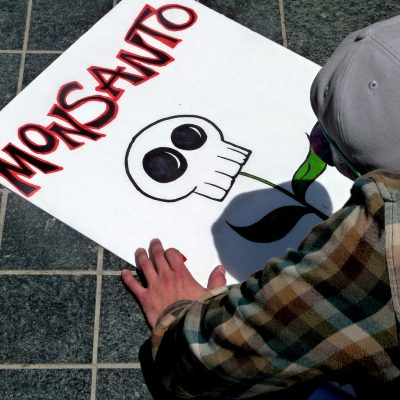It’s Farmer v. Monsanto in Court Fight over Dicamba Herbicide
Bader Farms claims Monsanto induces farmers to buy dicamba-tolerant seeds

A showdown is underway in the Midwest as the owner of a large Missouri peach farm seeks to hold the former Monsanto Co. accountable for millions of dollars in damage to his crops—losses the farmer claims resulted from a corporate strategy to induce farmers to buy high-priced specialty seeds and chemicals.
The trial got underway on January 27 in US District Court in Cape Girardeau, Missouri. Farmer Bill Bader, who has grown peaches in Missouri’s “Bootheel” region for 40 years, is seeking more than $20 million. The lawsuit alleges that Bader Farms lost more than 30,000 trees due to Monsanto’s actions, in collaboration with German chemical giant BASF, to profit from a new cropping system involving genetically engineered seeds designed to tolerate dousing of the herbicide dicamba.
Bader claims Monsanto sold GMO dicamba-tolerant soybean and cotton seeds despite knowing the actions would trigger chemical damage to farm fields that were not planted with the new seeds. The intent, the Bader Farms’ lawsuit alleges, was to induce farmers to buy the specialty seeds as a means to prevent crop damage from herbicide drift coming from neighboring farmers who were planting the GMO crops and spraying them with dicamba.
Testing showed that leaves of his dying peach trees carried traces of dicamba. The 5,000-acre family farm, which produced 5 million to 6 million pounds of peaches annually along with corn, soybeans, various berries, apples, and tomatoes, is now struggling to survive, according to Bader.
Monsanto, which was bought by Bayer AG in 2018, and BASF, which initially developed dicamba in the 1950s, have claimed that other factors are to blame for Bader’s problems on his farm, including a soil fungus. The companies deny they have any liability for his losses.
But among the evidence introduced at the Bader Farms trial are internal Monsanto documents showing that the company predicted thousands of drift complaints would occur after its new seed product launch.
Bader is only one of a large and growing group of US farmers who say they are the victims of a clearly foreseen chemical catastrophe many years in the making that has ruined crops covering millions of acres of farmland. Other lawsuits making similar claims have been filed on behalf of farmers from Mississippi, Kansas, Nebraska, Illinois, and several other key farming states.
Dicamba has been in use for more than 50 years, but traditionally farmers avoided applying the herbicide during warm months when crops were growing and did not apply it over large swaths of land due to the well-known propensity of the chemical to drift far from intended target areas.
That changed in recent years due to the waning effectiveness of a separate weed-killing chemical called glyphosate. Introduced by Monsanto in the 1970s, glyphosate was considered a highly effective weed killer for decades. Monsanto introduced genetically engineered glyphosate-tolerant crops in the 1990s, and as the company had planned, use of glyphosate herbicides exploded in agriculture. But with the expanded use of glyphosate, many weed varieties developed resistance to the chemical, a problem several scientists had warned the company would develop.
To combat the weed resistance, Monsanto decided to launch a new dicamba herbicide and sell new genetically altered seeds that would allow farmers to spray whole fields of crops directly with dicamba just as they had been doing with glyphosate, killing the weeds but allowing the crops to thrive.
Monsanto announced in 2011 that it was collaborating with BASF in developing the dicamba cropping systems and received regulatory approval for its “Xtend” GMO seeds in 2015. The company’s dicamba herbicide is called “XtendiMax.” BASF’s dicamba herbicide is called Engenia.
Just as scientists had warned of weed resistance with glyphosate, many scientists warned Monsanto that the new uses of dicamba would likely devastate farms not growing dicamba-tolerant GMO crops. The company assured growers its version of dicamba would not drift.
But then the company released its new seeds to the market before its new dicamba formulation was approved by the EPA, leading to scenarios in which farmers buying the new GMO crops started spraying old versions of dicamba in large volumes in warm months.
In addition to large fields of crops, dicamba drift is also reportedly damaging trees, gardens, and wildflowers that bees rely on for nutrition.
Officials at Bayer, which owns Monsanto, maintain that improved farmer training is resolving the issue.
Steve Smith, director of agriculture at Red Gold Inc, the world’s largest canned tomato processor, said Red Gold has managed to avoid damage to its produce so far but his own personal fruit trees at his residence have been wiped out. Smith has been lobbying for years for tight restrictions on the new dicamba system.
Smith, who was a member of an advisory council to Monsanto on dicamba, testified at the Bader trial, telling jurors that the company had ample warnings of the risks its dicamba system carried for farmers.
In 2012, Smith helped lead a coalition of more than 2,000 US farmers and food companies that sought to force government regulators to analyze the potential problems with the new dicamba system and a similar system using the herbicide 2,4-D, declaring then that the new herbicides posed a “real threat” to “nearly every food crop.”
He reiterated that point in an interview with Sierra. “We told them (Monsanto) over and over again it was not a good idea,” Smith said. “They keep saying it’s a matter of educating the growers. But the problem is not education; the problem is chemistry.”
*
Note to readers: please click the share buttons above or below. Forward this article to your email lists. Crosspost on your blog site, internet forums. etc.
Featured image is from Maui Independent

